Menus
- The reason machines among the naked bikes
- BMW K 1300 R – the defoliated one
- Honda CB 1000 R – the gentle one
- Kawasaki Z 1000 – the reborn
- Suzuki B-King – the underrated
- Yamaha FZ1 – the unfinished
- MOTORCYCLE measurements
- Conclusion
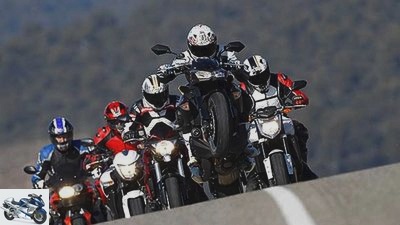
j.kuenstle.de
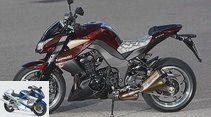
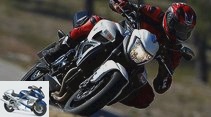
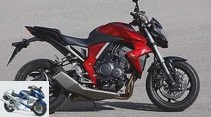
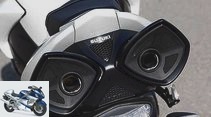
39 photos
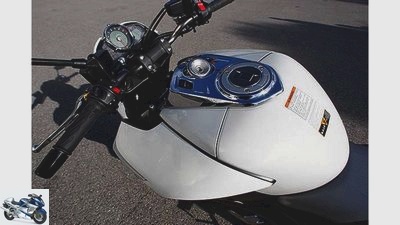
1/39
Suzuki B-King: Price 14,490 euros, additional costs around 145 euros.
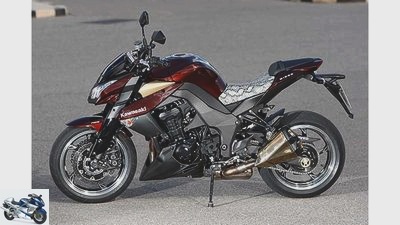
2/39
Kawasaki Z 1000: Price 11,295 euros, additional costs around 180 euros.
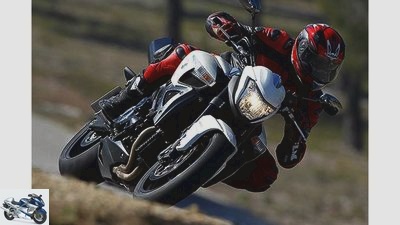
3/39
Suzuki B-King: The optical gigantism is deceptive. The B-King drives like a good all-rounder – but is much, much stronger.
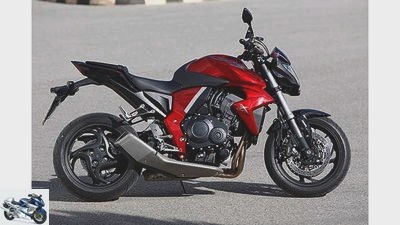
4/39
Next candidate: Honda CB 1000 R.
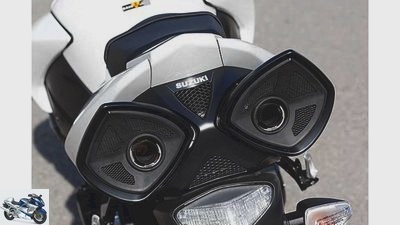
5/39
Suzuki B-King: The daring design did not lead to market success.
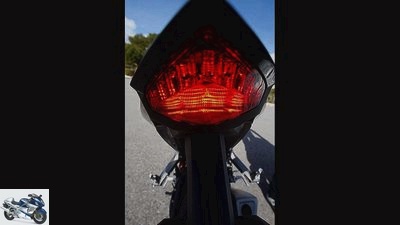
6/39
Honda CB 1000 R: Price 10690 euros, additional costs around 170 euros.
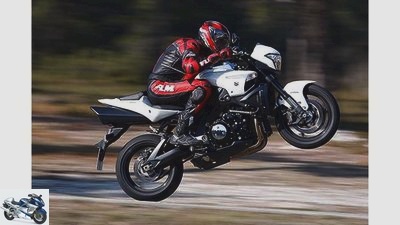
7/39
Suzuki B-King.
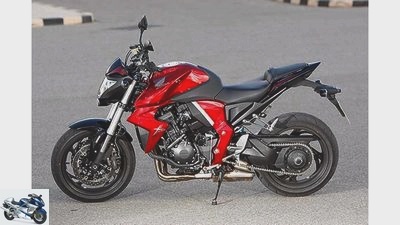
8/39
Honda CB 1300 R: The Honda only conveys the radical naked bike feeling visually. Technically, handling dominates – and perfection.
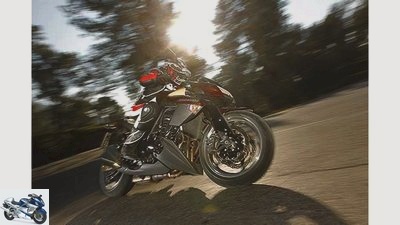
9/39
Kawasaki Z 1000.
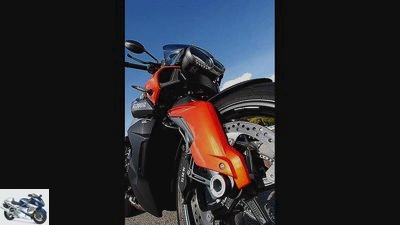
10/39
BMW K 1300 R: Price 13,900 euros, additional costs around 206 euros.
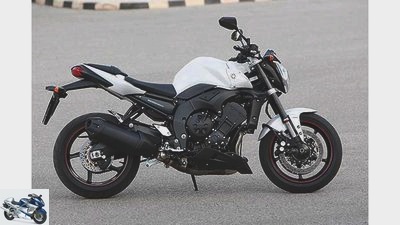
11/39
Yamaha FZ1: last candidate in the naked bike quintet.
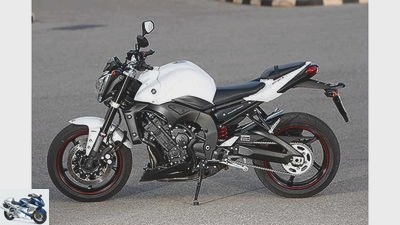
12/39
Yamaha FZ 1: Price 11,195 euros, additional costs around 170 euros.
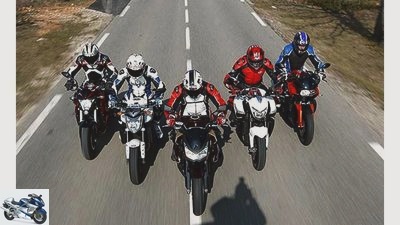
13/39
Which naked bike has the edge in the 1000-point ranking??
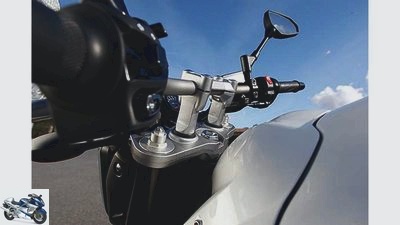
14/39
Yamaha FZ 1: it inspires drivers with a penchant for streetfighters.
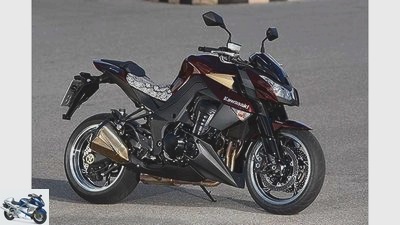
15/39
Candidate with tradition: Kawasaki Z 1000.
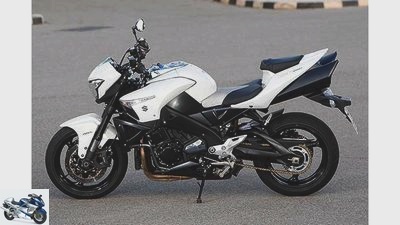
16/39
Suzuki B-King: a proud 1340 cubic capacity, measured 174 hp.
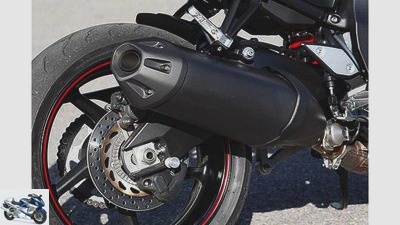
17/39
Yamaha FZ 1: abrupt increase in torque at 7000 rpm.
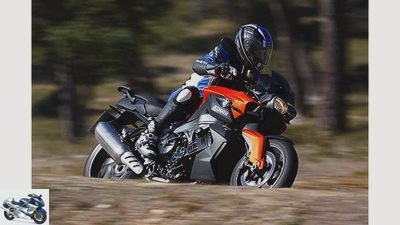
18/39
BMW K 1300 R..
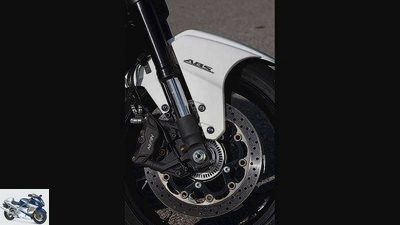
19/39
Suzuki B-King.
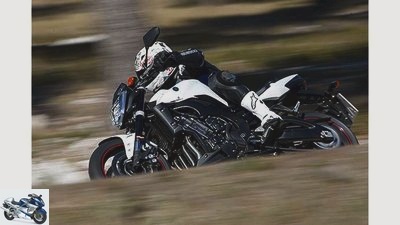
20/39
Yamaha FZ 1: there is only one thing missing – more torque. The streetfighter image still comes across.
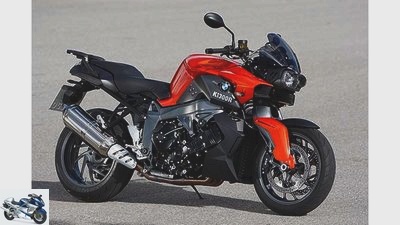
21/39
It starts with the BMW K 1300 R..
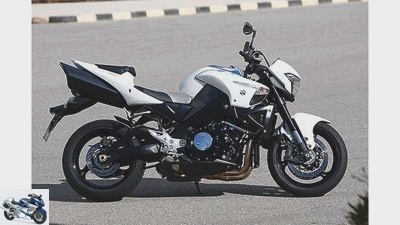
22/39
Suzuki B-King: the underestimates.
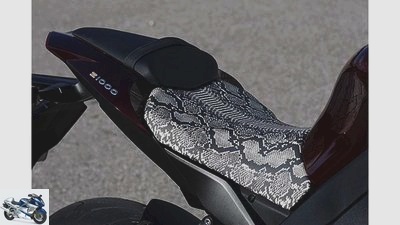
23/39
Kawasaki Z 1000: the snakeskin look polarized.
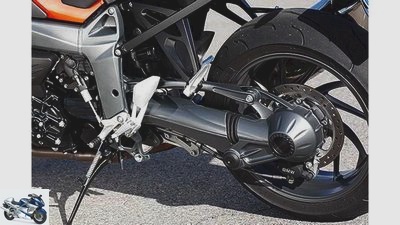
24/39
BMW K 1300 R: unconventional chassis with Duolever at the front and Paralever at the rear.
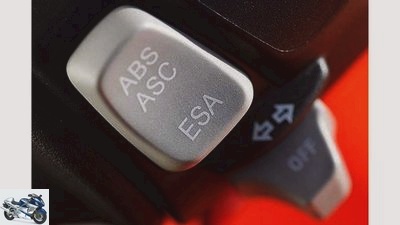
25/39
Rare on naked bikes, typical for BMW – electronic driving aids.
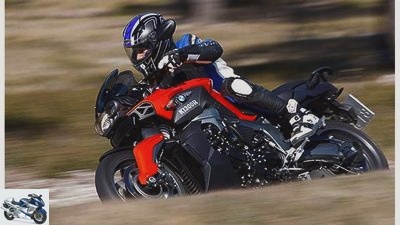
26/39
The BMW K 1300 R (730 points) wins with a clear lead: With a first-class chassis and a brutal engine, the BMW definitely fulfills the specifications of an emotional power naked bike – and saddles the sensible (comfort, equipment) on top.
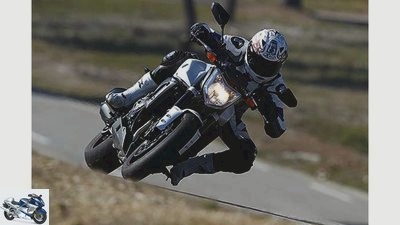
27/39
Yamaha FZ1.
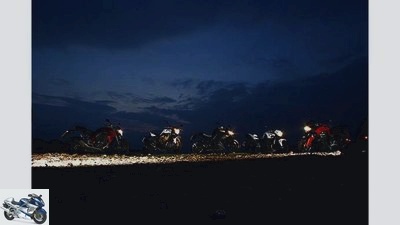
28/39
The rest of the field serves the naked bike fan base through conceptual rather than qualitative differences. The Suzuki (663 points) inspires performance-loving big boys, the Honda (657 points) result-oriented perfectionists, the Kawasaki (649 points) those who are also otherwise passionate, and the Yamaha (633 points) power types with a penchant for streetfighters.
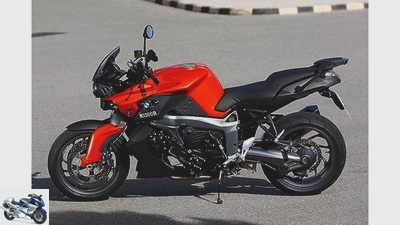
29/39
The defoliated: The "R." comes directly from the disguised S model.
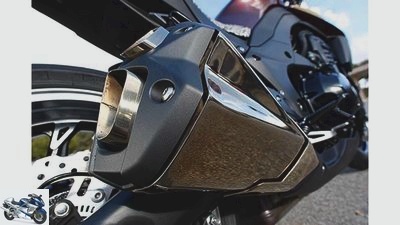
30/39
Kawasaki Z 1000: the Z builds on a great tradition – and proves that four-cylinder engines can also have character.
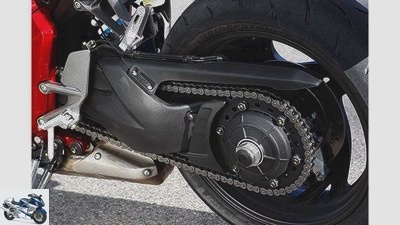
31/39
Honda CB 1000 R..
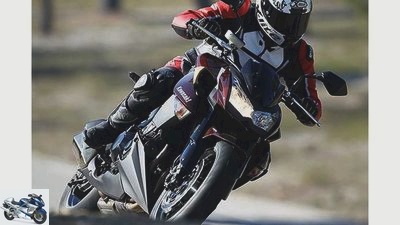
32/39
Kawasaki Z 1000: Kawasaki has succeeded in creating an expressive naked bike.
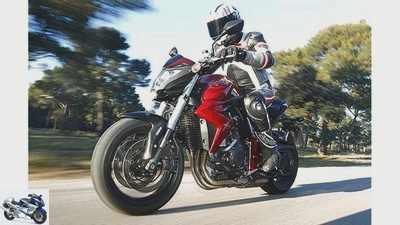
33/39
Honda CBR 1000 R..

34/39
Honda CB 1000 R..

35/39
Honda CB 1000 R: Its handiness is unrivaled in the naked bike segment.
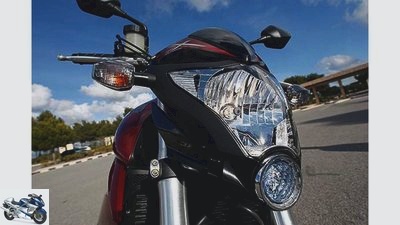
36/39
Honda CB 1000 R: Price test motorcycle 11,490 euros, including ABS 600 euros, special paintwork 200 euros.
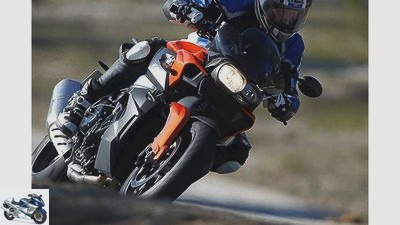
37/39
Price test motorcycle 17 210 euros with safety package (1400 euros), Comfort package (700 euros), ESA (electronic suspension adjustment) 740 euros, luggage rack 110 euros, automatic gearshift (360 euros).
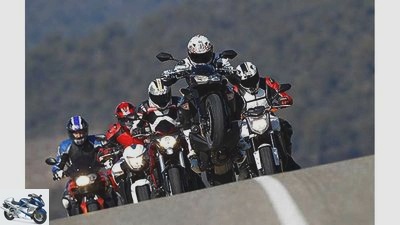
38/39
Big naked bike test 2010. MOTORRAD divided the eleven candidates into two groups this year: reason machines and emotion machines. Here are the so-called reason machines: …
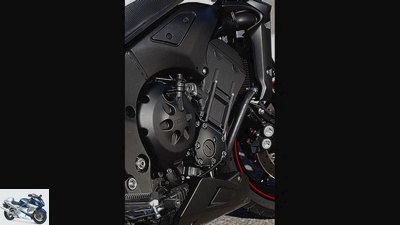
39/39
Yamaha FZ 1: 150 hp at 11400 rpm.
Comparison test of naked bikes, BMW K 1300 R, Honda CB 1000 R, Kawasaki Z 1000, Suzuki B-King, Yamaha FZ1
The reason machines among the naked bikes
These four-cylinders not only stand for common sense made metal, they also impress with their charm and character.
Reason. Is this term still appropriate given the engine and driving performance offered? Finally, the quintet entered the Honda CB 1000 R with 123 hp and typed the BMW K 1300 R and Suzuki with over 170 horses B.-King to the bar that superbikes put. But performance becomes relative when the untamed airflow sets its limits early. Then character, appearance, sympathy – and certainly also reason – count in the form of reliable technology, distinctive driving dynamics, an acceptable price and ABS.
Buy complete article
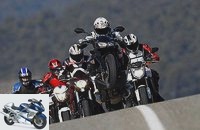
Comparison test of naked bikes
The reason machines among the naked bikes
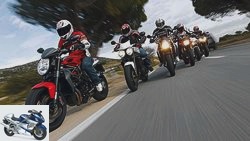
Naked bike
Comparison test of naked bikes
Comparative test of naked bikes – emotion machines
read more
BMW K 1300 R – the defoliated one
j.kuenstle.de
The defoliated: The “R” comes directly from the faired S model. Rare on naked bikes, typical for BMW – electronic driving aids.
She followed suit, the tall nude from Munich. Since the displacement increase to 1293 cm³ last year, shares the title of the most potent undisguised (if you ignore the Yamaha Vmax muscle bike) with Suzuki’s stunner, the 174 hp B-King. And yet, the Bavarian is not entirely committed to the popular naked bike ideal. The handlebar, which is shaped as a cast part, is more cranked and attached lower, the seat hollow has been moved further back, the driver is therefore much flatter over the tank than is usual with all other necklines. The reasons are profane: the grimly styled BMW is technically in direct line with its sister model, the K 1300 S sports tourer. Disguise removed, lamp mask and a few optical retouches on – the R. And with it a naked bike of a different kind. No streetfighter feeling, no upright sitting position, just different.
Only those who are open to it will discover the world of experience "R." – precisely because it relies on facts instead of emotions. He is seduced by this most brutal of all approaches, as evidenced by the stopwatch, and is enthusiastic about the measurably most vehement and most efficient deceleration in series motorcycle construction. Probably just like about the stoic calm and sovereignty with which the unconventional chassis (Duolever front, Paralever rear) bends around radii of all kinds. Naked bike purists will hardly accept that nice driving aids such as the gearshift assistant (360 euros) make clutch-free and uninterrupted upshifts a little experience again and again, or the electronic suspension setting ESA (740 euros) effectively changes the suspension setting at the push of a button – which doesn’t hide the facts. Because even if the "R." An unconventional naked bike and, at almost 16,000 euros with full equipment, is still an extremely expensive one, it remains one thing despite everything: a damn good one.
Technical specifications:
Four-cylinder in-line engine, six-speed gearbox, cardan shaft. Displacement 1293 cm³, rated output 127.0 kW (173 hp) at 9250 rpm, max. Torque 140 Nm at 8250 rpm, bridge frame made of aluminum, ABS. Tires 120/70 ZR 17; 190/55 ZR 17, seat height * 830 mm, weight with a full tank * 252 kg, payload * 208 kg, tank capacity 19.0 liters. Price 13,900 euros, test motorcycle ** 17210 euros, additional costs around 206 euros
* MOTORCYCLE measurements
** including safety package (1400 euros), comfort package (700 euros), ESA (electronic suspension adjustment) (740 euros), luggage rack (110 euros), automatic gearshift (360 euros)
Honda CB 1000 R – the gentle one
j.kuenstle.de
The gentle one: The Honda only conveys the radical naked bike feeling visually. Technically, handling dominates – and perfection.
The Honda dealers will still fondly remember the start of the 2008 season. It was sold out, the first delivery of the CB 1000 R. Blind orders. Without test drive, without discount. The reason: their appearance. The slim, not overly aggressive line, the minimalist rear, the single-sided swing arm on the left, the tightly snug stub exhaust on the right – a stylistic precision landing. A technical one too. Like a lover, the wasp waist of the CB literally sucks its master into its narrow lap, with a short tank and handlebars attached to the front, pushing him to the front of the vehicle. If there were haptics assigned to the naked bike genre, it would have to feel just like that – and certainly ride the same way. As easily as the lightest with a full tank of 220 kilograms and with the narrowest soled sole of the quintet with a 180 mm rear tire, it can be thrown into any curve radius as nimbly from one lean angle to the other, that is sensational – and for some it is terrifyingly good.
Because the comfortably tuned Honda chassis has absolutely nothing warlike, nothing aggressive, just offers functionality in its purest form. With an engine that complements exactly this character. Instead of the infernal howl of war, the four-cylinder, tamed to 123 hp, of the originally 160 hp 2007 fire blade pulls through the speed range with the gentle yet voluminous use of a string orchestra. Makes pressure and speed hardly felt, only measurable. Subjectively, no one would believe that this domesticated drive could easily counteract even the wild 1000s from Kawasaki and Yamaha when accelerating to 140 km / h. Typical for a Honda. Incidentally, an argument that fans and opponents of the brand alike use.
Technical specifications:
Four-cylinder in-line engine, six-speed gearbox, O-ring chain, displacement 998 cm³, rated output 92.0 kW (125 PS) at 10,000 rpm, max. Torque 99 Nm at 7750 rpm, central tubular frame made of aluminum, ABS, tires 120/70 ZR 17; 180/55 ZR 17, seat height * 830 mm, weight with a full tank * 220 kg, payload * 190 kg, tank capacity 17.0 liters. Price 10690 euros, price test motorcycle ** 11490 euros, additional costs around 170 euros
* MOTORCYCLE measurements
** including ABS (600 euros), special paint (200 euros)
Kawasaki Z 1000 – the reborn
j.kuenstle.de
The reborn: The Z 1000 builds on a great tradition – and proves that four-cylinder engines can also have character.
Z, that letter alone was enough to know who was meant. Z stood for Kawasaki. Initially (from 1972) for the Z 900, later (from 1976) for the Z 1000. And Z stood for evil, radical and uncompromising – until the revival of the Z 1000 for the 2003 season. It was beautifully styled, but suddenly the Z stood for tame. Moderate pressure from below, awkward handling – that had to be different. And in 2010 it was different, the new Z. The brand new engine with 1043 cm³ instead of 953 cm³ displacement, the frame made of aluminum instead of steel, new swing arm, new deflection, new exhaust, all for one single goal: The Z finally had to be used again stand angry.
And so much in advance: It worked. The new one is the old one again, the very old one. The four-in-line engine starts to muck out just above idle speed and immediately kicks the pilot in the cross. Ground four-cylinder running culture? Gentleness? Things for wimps. Even the balancer shaft appears to be doing its job incompletely on purpose. But the gentle tingling sensation in the handlebar ends does not bother you, it even supports this permanent need to show life and convey feelings.
Without making this claim an end in itself. This is ensured not least by the final sprint fueled by 137 hp in higher engine speeds. The fact that the seating position moved towards the steering head, the tank more compact (with 15 instead of 18.5 liters, unfortunately, also smaller) and the handlebars are straighter than on the previous model is almost self-evident with this constructive consistency. In this respect, the deliberately tight coordination of the suspension belongs and the objectively rough engine is part of the concept. In which only the relatively sluggish handling and – especially in comparison to the Honda – more expansive dimensions disturb. Nevertheless: With the Z 1000, Kawasaki has undoubtedly succeeded in creating an expressive naked bike. And that was probably the goal.
Technical specifications:
Four-cylinder in-line engine, six-speed gearbox, O-ring chain, displacement 1043 cm³, rated output 101.5 kW (138 PS) at 9600 rpm, max. Torque 110 Nm at 7800 rpm, backbone frame made of aluminum, ABS. Tires 120/70 ZR 17; 190/50 ZR 17, seat height * 815 mm, weight with a full tank * 222 kg, payload * 179 kg, tank capacity 15.0 liters. Price 11,295 euros, additional costs around 180 euros
* MOTORCYCLE measurements
Suzuki B-King – the underrated
j.kuenstle.de
The underestimated: the optical gigantism is deceptive. The B-King drives like a good all-rounder – but is much, much stronger.
No risk, no fun – no fun without risk. A motto that the designers of the B-King have long since found nothing to do with. Because the courage to look bold was not worth it in the case of their creation. The big bike, which was presented in 2007 and cost 14,500 euros, never became a market success. Despite the largest displacement with 1340 cm³, despite the record level of measured 174 hp. It’s a shame, because – nicely packaged – it would have what it takes to be the queen of all naked people. After all, behind the overflowing plastic facade around the tank and rear is essentially the solid technology of the 2008 Hayabusa.
The frame profiles of the monster spread the pilot’s legs wide, long lower legs struggle to clamp between footrests and the bulging air scoops. But when it succeeds, everything suddenly changes. Optics and ergonomics go their separate ways. The pleasantly shaped handlebar lies perfectly in the hand, the footrests allow an open knee angle, and the seat cushion is comfortable. Therefore, the mind gives the all-clear: Take it easy, this colossus could still be your friend.
And at the latest when the left foot is stepping through the aisles, it will finally be too. Rotational speeds wither into abstract numbers on the dominant display in the cockpit. From as little as 1200 revolutions (!) This four-cylinder pulls in as full, controllable and with little vibration as hardly any other motorcycle engine, transforming the throttle grip into a center of power. The B-mode designed for rain-soaked roads, which takes a full 50 hp from this splendid unit, borders on blasphemy and will probably never be used.
If only because the chassis is not impressed by this performance and the massive 259 kilograms live weight. The suspension is highly sensitive to all impacts, dampens smoothly and circles this colossus precisely and calmly even around narrow lines, despite the 200 tire on the rear wheel rim. Ultimately, this continues the character of the engine in a straight line. And one thing is certain: that too can mean emotion.
Technical specifications:
Four-cylinder in-line engine, six-speed gearbox, O-ring chain, displacement 1340 cm³, rated output 135.0 kW (184 PS) at 9500 rpm, max. Torque 146 Nm at 7200 rpm, bridge frame made of aluminum, ABS. Tires 120/70 ZR 17; 200/50 ZR 17, seat height * 810 mm, weight with a full tank * 259 kg, payload * 201 kg, tank capacity 16.5 liters. Price 14,490 euros, additional costs around 145 euros
* MOTORCYCLE measurements
Yamaha FZ1 – the unfinished
j.kuenstle.de
The unfinished: The FZ1 is missing one thing – more torque. The streetfighter image still comes across.
Everyone’s favorite, no, the FZ1 definitely doesn’t want to be. It speaks plain language – with its massive frame, the equally massive optics and, above all, the massive engine. Lifted straight out of the R1 super sports car. Despite technically complex cultivation measures, still a huge 150 hp. That sits. Just like the shock on the first tour. Start at the bottom? Against all expectations, moderate. After that? Still reluctant. And then? Then she swings the club – but only from 7000 tours.
This is by no means the character you would expect from a muscleman with a one-liter engine. The revised mapping for the 2010 model year has not changed anything significantly. On the contrary. It carved this club out of an even thicker piece of wood. Because the abrupt increase in torque at the 7000 mark is even more extreme, almost like a step (see the diagram on page 30). Whether that was really the intention of the developers?
As little consolation remains that a certain experience value can be ascribed to this eruption. A kick that the rest of the FZ1 delivers anyway. Whether the handlebars stretched out towards the driver by striking risers, the wide knee brace or the firm suspension: the Yamaha likes the role of the streetfighter. And despite all the radicalism, still do not lose touch with real life. Brakes, handling and workmanship are at the highest level, and even passengers find an acceptable place on the Yamaha. And ABS has it anyway. Like all of her four Japanese and Bavarian colleagues, by the way. Which brings us back to the subject of common sense.
Technical specifications:
Four-cylinder in-line engine, six-speed gearbox, O-ring chain, displacement 998 cm³, rated power 110.3 kW (150 PS) at 11000 / min, max. Torque 106 Nm at 8000 rpm, bridge frame made of aluminum, ABS. Tires 120/70 ZR 17; 190/50 ZR 17, seat height * 800 mm, weight with a full tank * 230 kg, payload * 180 kg, tank capacity 18.0 liters. Price 11,195 euros, additional costs around 170 euros
* MOTORCYCLE measurements
MOTORCYCLE measurements
Drawing: archive
Power on the crankshaft. Measurements on Dynojet roller test stand 250, corrected according to 95/1 / EG, maximum possible deviation +/- 5%
Two-class society: The performance curves impressively demonstrate the imposing appearance of the engines of the BMW and Suzuki. This superiority is also clearly reflected in the driving performance. The rest of the trio play in the same league despite a difference of more than ten hp in their respective top performances. What is extremely noticeable in the diagram and in driving practice is the attack-like increase in torque of the Yamaha five-valve engine at 7000 rpm, which was even more blatant than before in the 2010 model. The moderate fuel consumption of the quintet remains pleasing, with which even the heavy B-King is still the most economical.
Readings:
Top speed:
| Manufacturer information | Km / h |
| BMW | 270 | Honda | 230 |
| Kawasaki | 240 | Suzuki | 247 |
| Yamaha | 252 |
acceleration:
| Manufacturer information | 0-100 km / h |
0-140 km / h |
0-200 km / h (sec.) |
| BMW | 2.9 | 4.3 | 7.9 | Honda | 3.2 | 5.3 | 11.2 |
| Kawasaki | 3.3 | 5.2 | 9.9 | Suzuki | 3.1 | 4.6 | 8.1 |
| Yamaha | 3.6 | 5.4 | 10.3 |
Draft:
| Manufacturer information | 60-100 km / h |
100-140 km / h |
140-180 km / h |
| BMW | 3.2 | 3.2 | 3.4 | Honda | 3.7 | 3.5 | 4.1 |
| Kawasaki | 3.3 | 3.3 | 3.4 | Suzuki | 4.0 | 3.6 | 4.2 |
| Yamaha | 4.1 | 4.1 | 5.1 |
Fuel consumption (Country road):
| Manufacturer information | Liters / 100 km |
| BMW | 5.5 | Honda | 5.2 |
| Kawasaki | 5.5 | Suzuki | 5.0 |
| Yamaha | 5.4 |
Theoretical range (Country road):
| Manufacturer information | Km |
| BMW | 345 | Honda | 327 |
| Kawasaki | 273 | Suzuki | 330 |
| Yamaha | 333 |
Conclusion
j.kuenstle.de
Despite the title "Reason bikes" all five convey a clear streetfighter feeling.
1st place: BMW K 1300 R
2nd place: Suzuki B-King
3rd place: Honda CB 1000 R
4th place: Kawasaki Z 1000
5th place: Yamaha FZ1
Who should win in the group of reason-oriented naked bikes other than the most sensible? For fans of pure teaching: With a first-class chassis and a brutal engine, the BMW definitely fulfills the specifications of an emotional power naked bike – and saddles the sensible (comfort, equipment) on top. The rest of the field serves the naked bike fan base through conceptual rather than qualitative differences. The Suzuki inspires performance-loving big boys, the Honda results-oriented perfectionists, the Kawasaki those who are otherwise passionate about feeling, and the Yamaha power types with a penchant for streetfighters.
Scoring:
Category engine:
There is no question that when it comes to sheer power, the BMW and the Suzuki don’t bother. The result of the pure measured values goes to the power duo. The displacement advantage naturally also has an impact when starting from low speeds (engine characteristics). The third most powerful machine, the 150 hp Yamaha, awards the theoretical claim to the bronze medal in the pull-through rating due to its low-starting engine and an overall gear ratio that is too long. After all, the FZ1 returns the favor with its extremely cultivated five-valve engine.
Winner engine: BMW
Category chassis:
With high-precision steering behavior and the extremely easy and effectively adjustable ESA suspension, BMW lays the foundation for victory in this category. The Suzuki follows with a respectful distance, which impresses above all with its well-coordinated, comfortable suspension elements. The Honda closely follows, the handiness of which is unrivaled in the naked bike segment. The Kawasaki, which is also fundamentally geared towards agile handling, has to be able to distance itself from the Honda mainly through slow turning behavior. In the chassis segment, the Yamaha is in the midfield in all areas and cannot really put itself in the limelight with this overall picture.
Chassis winner: BMW
Category everyday life:
Isn’t this about reason-oriented naked bikes? It is understandable that the BMW shines with the greatest range, the most extensive equipment and the best light. In the narrow field of persecutors, even secondary virtues can become decisive. The Yamaha gets its points, for example, with a good passenger comfort, which pushes it just ahead of the Suzuki (high payload) in the table. The Honda messed up especially the poor visibility in the rear-view mirrors – the mirrors build up to ten centimeters narrower than the competition – the balance sheet. The Kawasaki loses points mainly due to the 3.5 liter smaller tank compared to the previous model.
Winner everyday life: BMW
Category Security:
The deceleration performance, which can hardly be topped, brings the BMW forward. But even the Suzuki and Honda are in this respect, apart from the lower possible braking power in the ABS control range, no nakedness. The radial brake system of the Kawasaki even shines with its almost perfect controllability, but without being able to stand out from the Yamaha overall.
Safety winner: BMW
Category costs:
BMW, Honda and Yamaha are on par – with a slight advantage (warranty and moderate inspection costs) for the K 1300 R. Two things: lowest consumption and most expensive maintenance for the B-King.
Winner costs: BMW / Honda / Yamaha
| Max points |
BMW K 1300 R. |
Honda CB 1000 R. |
Kawasaki Z 1000 |
Suzuki B-King |
Yamaha FZ1 |
Overall rating | 1000 | 730 | 657 | 649 | 663 | 633 |
| placement | 1. | 3. | 4th. | 2. | 5. | Price-performance note | Top grade 1.0 | 1.9 | 1.8 | 2.0 | 2.6 | 2.2 |
Price-performance winner: Honda
Finally no BMW up front: an almost perfect motorcycle at a fair price – the Honda CB 1000 R.
Related articles
-
Naked bikes with four-cylinder engines in the test
Photos: 26 photos 1/26 Yes, slowly through the village is also possible. 2/26 The middle class is changing. Can they…
-
The big naked bike comparison test: reason versus emotion
j.kuenstle.de 39 photos 1/39 Suzuki B-King: Price 14,490 euros, additional costs around 145 euros. 2/39 Kawasaki Z 1000: Price…
-
Comparative test of athletes against naked bikes
fact comparative test athletes versus naked bikes Family twist: athletes versus naked bikes They come from a family, and yet they are worlds apart ….
-
Comparative test of naked bikes from Germany, Austria, USA, Great Britain
Art 21 pictures BMW 1/21 BMW 2/21 BMW 3/21 BMW 4/21 BMW 5/21 BMW 6/21 BMW 7/21 BMW 8/21 BMW 9/21 BMW 10/21 BMW 11/21 BMW 12 / 21 BMW 13/21 BMW 14/21 BMW …
-
Comparison test of naked bikes from Japan
Artist 15th photos Artist 1/15 Artist 2/15 Artist 3/15 Artist 4/15 Artist 5/15 Artist 6/15 Artist 7/15 Artist 8/15 Artist 9/15 Artist 10/15 Artist 11/15…
-
Comparative test of 800 naked bikes
31 photos 1/31 Winner price-performance ratio Yamaha MT-09: Most points and the cheapest price, that can only give the best…
-
39 pictures 1/39 The Triumph Speed Triple: The price 11,740 euros (the test motorcycle with windshield for 245 euros and …
-
Comparison test of naked bikes from Italy
Art 7 pictures Ducati 1/7 Ducati Streetfighter / S Ducati 2/7 Ducati Streetfighter / S Ducati 3/7 Ducati Streetfighter / S Ducati 4/7 Ducati Streetfighter / S …
-
Test naked bikes Aprilia, Benelli, Ducati, Kawasaki, KTM, Suzuki and Yamaha
Naked bikes from Aprilia, Benelli, Ducati, Kawasaki, KTM, Suzuki and Yamaha Seven naked bikes in a comparison test Content of Naked bikes…
-
Comparison test: large naked bikes
fact Comparison test: Large naked bikes, BMW K 1300 R, Honda CB 1300 S, Suzuki B-King, Yamaha XJR 1300 Large naked bikes in comparison Content of An…